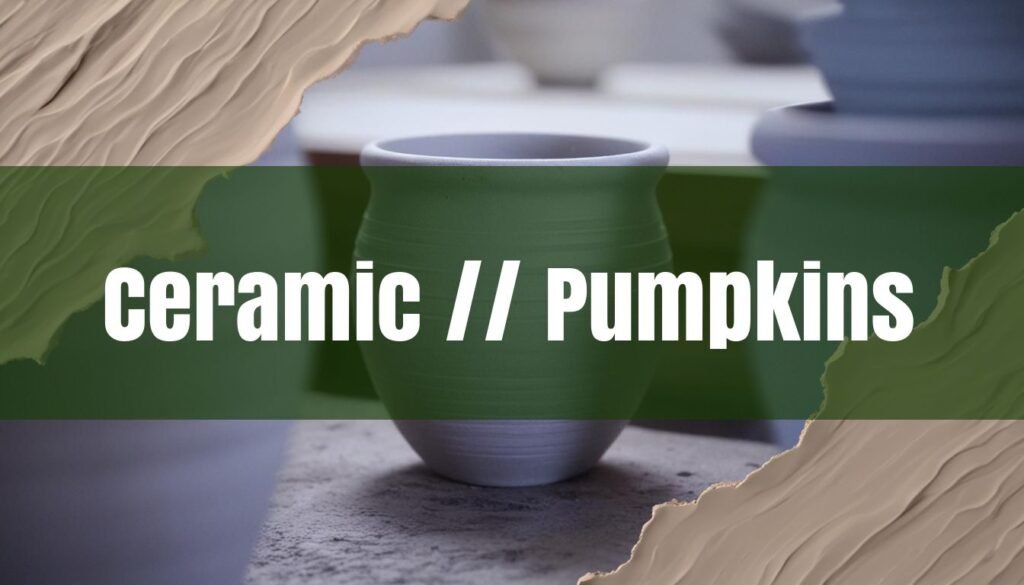Crafting ceramic pumpkins is a delightful way to embrace the autumn spirit and explore the versatility of clay. Whether you’re a beginner or an experienced ceramicist, the process offers a unique opportunity to create personalized decorations. This guide will walk you through the essentials, from selecting the right materials to applying creative glazing techniques, ensuring your ceramic pumpkins become cherished seasonal treasures. For more information about surface design, check out this article on unlocking ceramic surface design.
Essential Materials and Tools
First and foremost, the right materials and tools set the stage for a successful project. The choice of clay is crucial; stoneware or porcelain clay are both excellent options, known for their workability and ability to withstand high firing temperatures. For a white finish, consider using #240 White Clay C/6. Sculpting tools are your best friends in shaping the clay. A large loop tool is perfect for removing excess clay and establishing the pumpkin’s form. A double-ended ribbon tool is ideal for refining the shape and adding details, while a needle tool helps in creating fine lines and textures. A wooden modeling tool aids in smoothing surfaces, and a fettling knife is useful for trimming excess clay. Don’t forget a sponge and water spray gun for keeping the clay moist and cleaning up your work. For glazing, you’ll need underglazes in various colors, such as intense yellow, flame orange, and light green, along with a chocolate brown stain for the stem. Paintbrushes and a mixing palette are essential for applying and blending the glazes. Lastly, access to a kiln is necessary for firing your pumpkin.
Crafting Methods for Ceramic Pumpkins
There are several methods to bring your ceramic pumpkin to life, each catering to different skill levels and preferences. For beginners, using a mold is a straightforward option. Simply press clay into a pumpkin-shaped mold, ensuring it fills all the details, then carefully remove the molded form. Hand-building techniques offer more creative freedom. Pinching involves starting with a ball of clay and using your fingers to create a hollow form, gradually shaping it into a pumpkin. Coiling involves rolling clay into long, thin coils and layering them to build the pumpkin’s walls, blending the coils together as you go. For advanced users, wheel throwing allows you to create a seamless, hollow pumpkin form on the pottery wheel. Each method allows for unique variations in shape, size, and texture, letting your creativity shine. Learn about the essentials with this guide to pottery 101.
Drying and Firing Processes
After sculpting, the drying and firing processes are critical to the pumpkin’s structural integrity. Drying should be done slowly and evenly to prevent cracks. Uneven drying, where some parts shrink faster than others, is a primary cause of cracking. Ensure the pumpkin dries in a consistent environment, away from direct sunlight and drafts. Covering certain parts with wax resist can help slow down moisture loss in thinner areas. The firing process typically involves two stages: bisque firing and glaze firing. Bisque firing hardens the clay and prepares it for glazing. Glaze firing melts the glaze, creating a vibrant, durable surface. Follow a firing schedule that gradually increases the temperature to minimize the risk of cracking. Generally, a glaze firing is done at cone 6 / 1230 degrees celsius.
Glazing and Decoration
Glazing is where your ceramic pumpkin truly comes to life, adding color, depth, and personality. Before glazing, ensure your pumpkin has been bisque fired and is free of dust. There are several glazing methods to choose from, each offering unique effects. Brushing involves applying glaze with a brush, allowing for precise control over color placement and layering. Dipping involves submerging the pumpkin in glaze, providing an even coat. Spraying uses an airbrush to apply a thin, even layer of glaze, ideal for achieving smooth, consistent finishes. For a classic pumpkin look, mix intense yellow and flame orange Amaco Velvet Underglazes in a 50/50 ratio. Apply three coats for a rich, opaque color. For the stem, mix flame orange, intense yellow, green glaze, and a small amount of Scarva Nano chocolate brown stain for a realistic brown hue. As an optional step, you can add a transparent or clear glaze to create a shiny finish. Beyond basic glazing, consider adding surface decorations to make your pumpkin truly unique. Carving intricate patterns into the clay before firing can create stunning visual effects. Adding textures, such as cable knit patterns, can add tactile interest.
Ceramic pumpkins offer a fantastic blend of artistry and seasonal charm.
Embrace the process, experiment with different techniques, and let your creativity guide you. With the right tools, clay, and glazing methods, you can create unique and cherished decorations that capture the spirit of autumn.





